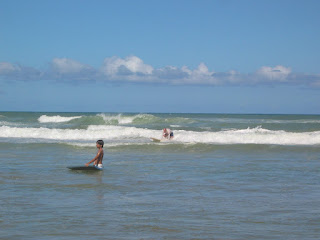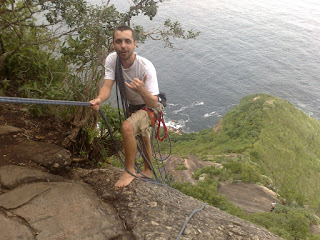The most famous beach in the world is of course Copacabana. It is shaped like an arc about 5 km long, between the
Forte de Copacabana and
Forte do Leme fortresses. Each year there is a swim race, the
Travessia dos Fortes, which is a 3800 m swim between the two fortresses. This happens to be the exact distance of an Ironman triathlon swim too. I really wanted to do that swim.
Since I had no pilot boat I had to stay close to the shore, rather than swimming the straight line distance. (Besides, I am notoriously bad at swimming in a straight line). The surf was fairly big that day, but there were no warning signs posted. Not until after I started my swim, anyway. But all went well and I swam the 5ish km in 1 hour and 19 minutes.


The sea was angry that day, my friend.

Finish, coming back inside the surf.

What could possibly have gone wrong?
The main event of the day was in fact the very reason why the visit to Rio had to be planned around Sunday April 20 in the first place. It was the day of the final of the
Taça Rio at Macaranã stadium; Botafogo vs. Fluminense. I wanted to make sure I was in the section with the supporters of the winning team, so applying all my wisdom I chose to side with Botafogo. That wisdom was partly based on Botafogo having a microscopic edge at the bookmakers, and mainly on Botafogo being the team of one of my all-time favourite players:
Garrincha. (He wasn´t playing today, what with having died 25 years ago).
Listen to the samba drums! They went on for the full 90 minutes. The guy pacing in the foreground also went on for the full 90 minutes, shouting directions to the players and praying to the gods. Literally.
Throughout the first half time Botafogo had a slight edge. They certainly had a very solid defense and more control of the midfield. Fluminense did not really get any chances -- well, except for that penalty kick they got. I captured the moment on video in the hopes of seeing the Botafogo fans erupt in case the penalty was missed (about a 20% chance in soccer). Pandemonium duly ensued as the kicker hit the post! Half time score 0-0.
More controversy with the referee in the 2nd half time as he awarded a second yellow card to one of the Botafogo players for a barely detectable foul. However, despite being a man down, Botafogo heroically scrambled in a goal 5 minutes before time, again captured on video by yours truly. The fans made Maracanã tremble on its foundations.

Botafogo campeão 2008!
To celebrate our glorious victory we went our to a
churrascaria, which is a steak house. We went to reputedly the best on in Rio, and as it turned out (good grief!) certainly the most expensive one: Porcão Rio. It's a
rodizio, meaning that it's buffet style where waiters continuously come round to your table with big skewers of various cuts of meat. This is part 1 of a 2-part experiment of comparing steak houses in Brazil versus Argentina. After the Porcão Rio I know which of the two my money is on.






















































